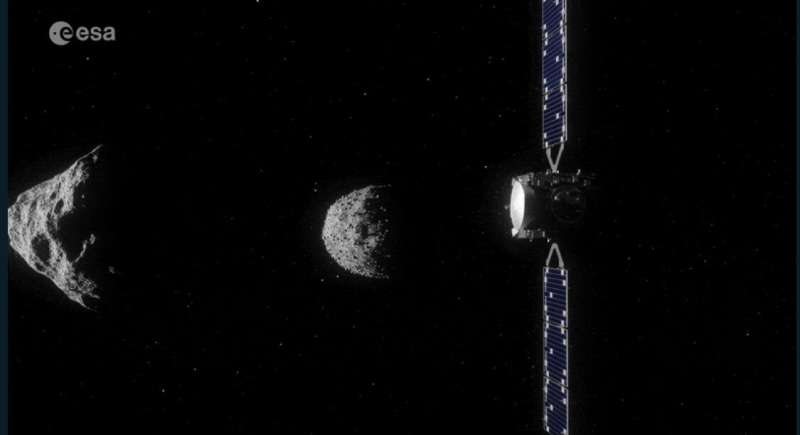Credit: ESA-Science Office
One of last year's space highlights was the NASA DART mission's collision with Dimorphos, the small moon of the binary asteroid Didymos (seen left). The impact measurably shifted the target asteroid's orbit around its primary while casting a plume of debris thousand of kilometers out into space.
Next comes ESA's Hera spacecraft which will return to the binary asteroid to perform a close-up survey of the crater left by DART, as well as measuring Dimorphos' mass and make-up, along with that of its central body.
"Hera is due to be launched in October 2024," explains Ian Carnelli, heading the mission. "In order to make that deadline our team has been working hard during the last year to finalize and test the various spacecraft subsystems—including the two CubeSats that will be deployed from Hera itself in the vicinity of Dimorphos. Meanwhile the overall mission passed its system Critical Design Review at the end of 2022, at the same time as Hera received funding for its launcher and operations.
"This coming year is when everything comes together: all elements of the Hera flight model are due to be integrated so that we can perform a full campaign of environmental testing on the spacecraft at ESA's ESTEC Test Center in the Netherlands. So this is going to be another extremely busy year, but at the end of it we aim to be well on track for launch."
Credit: ESA-Science Office
The ESTEC Test Center is the largest satellite test facility in Europe, equipped with facilities to simulate every aspect of the launch and space environment. Hera's spacecraft-level test campaign is forecast to begin in the autumn.
Hera will be equipped with automated guidance, navigation and control to allow it to safely navigate the double-asteroid system, akin in function to a self-driving car. Its desk-sized body will carry instruments including an optical Asteroid Framing Camera, supplemented by thermal and spectral imagers, as well as a laser altimeter for surface mapping. Hera is also three spacecraft in one, because it will also deliver a pair of shoebox-sized CubeSats to the vicinity of Dimorphos.
The Juventas CubeSat will perform the first ever radar probe of an asteroid interior, while also carrying a gravimeter and accelerometer to measure the body's ultra-low gravity and surface mechanical response. The other CubeSat, Milani—named after the mission's original inventor—will perform near-infrared spectral imaging and sample asteroid dust.
The CubeSat pair will remain in contact with their Hera mothership and each other through a novel inter-satellite link system, to build up experience of overseeing multiple spacecraft in exotic near-weightlessness, before eventually touching down on Dimorphos.
NASA's DART and ESA's Hera missions have been supported by the same international teams of scientists and astronomers, and take place through an international collaboration called AIDA—the Asteroid Impact and Deflection Assessment. Planetary defense has no borders and is a great example of what international collaboration can achieve.
Provided by European Space Agency























